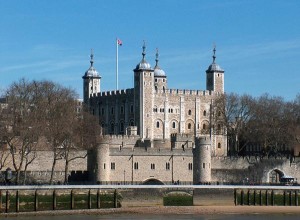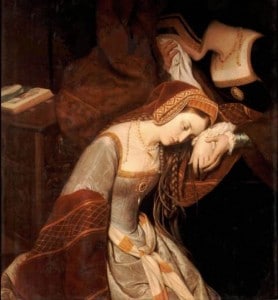 At dawn on the 2nd May 1536 Henry Norris, Henry VIII’s Groom of the Stool and great friend, was taken to the Tower of London. Mark Smeaton had also been taken there and Chapuys wrote to Charles V on the 2nd May telling him that:-
At dawn on the 2nd May 1536 Henry Norris, Henry VIII’s Groom of the Stool and great friend, was taken to the Tower of London. Mark Smeaton had also been taken there and Chapuys wrote to Charles V on the 2nd May telling him that:-
“The Concubine’s brother, named Rochefort, has also been lodged in the Tower, but more than six hours after the others, and three or four before his sister”1
and Wriothesley’s Chronicle2 is in agreement that Norris and Rochford were both taken to the Tower on the 2nd but nowhere is there any mention of George Boleyn, Lord Rochford, being interrogated first, unlike Norris and Smeaton. His arrest was also done so discreetly that his sister, Anne Boleyn, didn’t hear of it.
In “Las nuevas de Ynglaterra de la presion de la Manceba del Rey”, recorded in Letters and Paper on the 2nd May, it reports Rochford’s arrest as being to do with him covering up his sister’s crimes and being an accessory, rather than being one of her lovers:-
“The Emperor has letters from England of 2 May, stating that the mistress of the king of England, who is called queen, had been put in the Tower for adultery with an organist of her chamber, and the King’s most private “sommelier de corps.” Her brother is imprisoned for not giving information of her crime. It is said that, even if it had not been discovered, the King had determined to leave her, as he had been informed that she had consummated a marriage with the earl of Nortemberlano (Northumberland) nine years ago.”3
This leaves us wondering whether George Boleyn was arrested first and then the charge of incest made up later, a shocking and horrific allegation which would turn everyone against him and his sister.
From Tennis to the Tower
Alison Weir writes of how Anne Boleyn was watching her champion play a game of real tennis when she was disturbed by a messenger telling her that she must “by order of the King” immediately go and present herself before the Privy Council4. Although Anne was unaware that her brother had been arrested, this message, along with her husband’s abrupt departure from the May Day jousts the day before, must have frightened her. Anne was an intelligent woman who realised the potential repercussions of her reckless words Sir Henry Norris and must have been worrying about what was going to happen. So worried had Anne been that she had appealed to the King with Elizabeth in her arms and she had also asked her chaplain, Matthew Parker, on Wednesday 26th April, to take care of Elizabeth if anything happened to her5. The fact that she approached Parker days before she quarrelled with Norris suggests that Anne was already worried about her precarious position.
Anne Boleyn left the tennis match and presented herself in the council chamber in front of a royal commission consisting of the Duke of Norfolk (her uncle), Sir William Fitzwilliam and Sir William Paulet. There, she was informed that she was being accused of committing adultery with three different men, Mark Smeaton, Henry Norris and a third, and that Smeaton and Norris had already confessed6. Anne remonstrated with her accusers but her words had no effect and the royal commission ordered her arrest. Anne was then taken to her apartment until the tide of the Thames turned and then, at two o’clock in the afternoon, she was escorted by barge to the Tower of London7.

Anne Boleyn, the Lady in the Tower
At the Tower of London, it is likely that Anne’s barge would have entered through the Court Gate in the Byward Tower, rather than Traitor’s Gate8. She was met there by Sir Edmund Walsingham, the Lieutenant of the Tower and then taken to the Royal Palace where she encountered the Constable of the Tower, Sir William Kingston. Kingston wrote letters to Thomas Cromwell to keep him informed of Anne’s behaviour and the things she said during her imprisonment and he wrote of Anne’s arrival at the Tower in a letter dated the 3rd May:-
“On my lord of Norfolk and the King’s Council departing from the Tower, I went before the Queen into her lodging. She said unto me, “Mr. Kingston, shall I go into a dungeon?” I said, “No, Madam. You shall go into the lodging you lay in at your coronation.” “It is too g[ood] for me, she said; Jesu have mercy on me;” and kneeled down, weeping a [good] pace, and in the same sorrow fell into a great laughing, as she has done many times since. “She desyred me to move the Kynges hynes that she [might] have the sacarment in the closet by hyr chamber, that she my[ght pray] for mercy, for I am as clere from the company of man as for s[in as I] am clear from you, and am the Kynges trew wedded wyf. And then s[he said], Mr. Kynston, do you know wher for I am here? and I sayd, Nay. And th[en she asked me], When saw you the Kynge? and I sayd I saw hym not syns I saw [him in] the Tylte Yerde. And then, Mr. K., I pray you to telle me wher my [Lord, my fa]der, ys? And I told hyr I saw hym afore dyner in the Cort. O[where is m]y sweet broder? I sayd I left hym at York Place; and so I dyd. I [hear say, sai]d she, that I shuld be accused with iij. men; and I can say [no more but] nay, withyowt I shuld oppen my body. And ther with opynd her gown. O, No[res], hast thow accused me? Thow ar in the Towre with me, [and thow and I shall] dy together; and, Marke, thow art here to. O, my mother, [thou wilt die with] sorow; and myche lamented my lady of Worceter, for by c[ause that her child di]d not store in hyre body. And my wyf sayd, what shuld [be the cause? And she sai]d, for the sorow she toke for me. And then she sayd, Mr. [Kyngston, shall I die with]yowt justes? And I sayd, the porest sugett the Ky[ng hath, hath justice. And t]her with she lawed. Alle thys sayinges was yesterny[ght].”9
It is hard to imagine how Anne felt as she entered the Tower and how ironic for her to be imprisoned in the very apartments in which she spent the night before her coronation – the sumptuous Queen’s apartments in the Royal Palace (see my post Anne Boleyn and the Tower of London for details of Anne’s prison). No wonder Anne collapsed weeping and went from weeping to laughing. Her hysteria was caused by her realising the full extent of what was happening, afterall, she knew her husband well and she had seen what had happened to the likes of Sir Thomas More. We can see from her speech to Kingston that she was worried about dying without justice and that she was also worried about her brother; here Kingston lied because he knew full well that her brother was also in the Tower but it is likely that he was trying to be kind to an already hysterical woman.
Kingston would report Anne’s ramblings to Cromwell over the next few days and these words, spoken by a desperate and frightened woman, would lead to the arrests of Sir William Brereton and Sir Francis Weston and would be used as evidence against her and the men concerned. We can wonder what would have happened if Anne had stayed silent in the Tower, perhaps Brereton and Weston would have been saved, BUT there was no hope for Anne, George, Norris and Smeaton, they were facing a certain death.
The Queen’s Apartments in the Royal Palace
The following YouTube video, from TheBullen1, is about the Queen’s Apartments in the Royal Palace that once stood within the grounds of the Tower of London. They were renovated for Anne’s coronation in 1533 and acted as her prison in May 1536.
Notes and Sources
1 – L&P, x. 782
2 – Wriothesley’s Chronicle – online version, p36
3 – L&P, x. 784
4 – The Lady in the Tower: The Fall of Anne Boleyn, Alison Weir, p132
5 – Ibid., p93
6 and 7 – Anne Boleyn by Paul Friedmann, ed. Josephine Wilkinson, p232
8 – The Lady in the Tower: The Fall of Anne Boleyn, Alison Weir, p135
9 – L&P, x. 793
